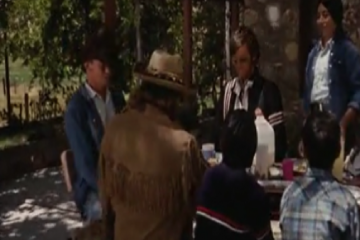Easy Rider is a 1969 American road movie directed by Dennis Hopper. The film stars Hopper (Billy) and Peter Fonda (Wyatt) as two bikers who visit and then leave behind a number of sub-cultures during a road trip from Los Angeles to New Orleans. The film deals with the key themes of generational disenfranchisement which was widespread across America in the late 1960s. In this sequence the filmmakers use composition, costume, and lighting in order to represent varied and contrasting gender identities prevalent at a time of significant cultural change.

We open with a tracking shot of Billy and Wyatt riding their motorbikes along a dirt track (Fig.1). Both characters are wearing attire respective of masculinity circa 1969. Hopper is wearing loose, brown clothing typical of the ‘male-hipster’ which dominated then liberal youth culture, whereas Fonda is wearing a black leather jacket decorated with an imprint of the American flag alongside a pair of slick sunglasses; a look which exerts masculine intimidation, patriotism, and a touch of rebellion. The composition of the shot creates a ‘frame within a frame’ illusion as Fonda and Hopper are positioned within the space between the uprights of a makeshift shack. This technique creates an impression of isolation and constraint for the two protagonists as they are seemingly two ‘city men’ stuck in a rural country setting. This impression is further suggested as children on a donkey steadily pass by the bikers within the same shot.

The dirt track represents Hopper and Fonda’s arrival into a world which has been abandoned by modern America, a time capsule of a by-gone era. The bikers encounter two older men dressed like cowboys: a trope of masculinity for a prior generation. The deep focus shot perfectly highlights the contrast between both pairs of men as they seemingly exert their masculine capability through opposing methods. The two cowboys dominate the shot as they are portrayed in the foreground mending a horseshoe whilst Hopper and Fonda fix their bikes in the background, relegated to shadows of the barn (Fig. 2). As John Gibbs notes, ‘The relationship between actors and lighting can create distinct meanings’ and here the choice to enshroud Hopper and Fonda in shadow suggests a negative judgement on the new era of masculinity whilst the cowboys (seeming relics of dated masculinity) remain vital and well-lit (2). The film may also here be indicating that Wyatt and Billy are committing a criminal act in contrast to the cowboys honest, hard work.
Although, Easy Rider may be a ‘buddy movie’ at the core, it drastically differs from the buddy movies of the preceding decades. Whereas films like Operation Pacific (1951) and The Searchers (1956) seemed to glorify masculinity, the buddy films of New Hollywood were self-aware about the decline of masculinity within youth culture (Benshoff & Griffin 281). A medium shot denotes one of the cowboys looking at the bikers from afar with a bemused expression that speaks to a wry amused judgement of this new generation of ‘emasculated men’ whose identities have been shaped largely by urban social movements such as second-wave feminism. It is evident therefore that the film represents the divide in types of masculinity, and attitudes towards them, prevalent at the time (Cohen & Hark 181).

In a prelude to the dinner scene, a wide shot includes a Latina woman helping prepare the food (Fig. 3). We discover the woman is the wife of the younger of the two cowboys, and her higher position in the frame and upright posture rather affirms her as an overseer or a guardian akin to the mothering and nurturing roles ascribed to women through the ‘natural laws’ outlined by patriarchal society. This idea is supported by the medium shot of her sitting next to the child (her main priority). She is perhaps also symbol of femininity from a previous generation; a rural, lower class woman who has been untouched by the progressive ideologies of second-wave feminism. She smiles in a close up shot when her husband gloats about her Catholicism thus suggesting that she proudly ascribes to a traditionally religious lifestyle as opposed to one shaped by current politics and societal trends. Her sly grins could even be read as a subtle mockery of both Fonda and Hopper’s characters as she may find new liberal youth culture as a form of ‘joke’ compared to her supposed ‘superior’ lifestyle. She appears generally comfortable in her archetypal ‘motherly’ role thus suggesting that, whilst they did not particularly align with the then feminist ideal, traditional marital roles were still a viable form of family structure in America as long both parties were satisfied with their gendered duties. In addition, the racial mixing taking place in the family group on the homestead points to some flexibility not normally ascribed to conservative views of western settlement. The sequence concludes with a myriad of tracking shots of Hopper and Fonda’s characters back out on the road. The natural lighting in amalgamation with the character’s hopeful expressions paints an impression that they are back in a world where they belong: a modern world where the roads are paved and bikes allow them to keep on the move, avoiding the fixed identities on offer.
References
Benshoff, H. and Griffin, S., America On Film: Representing Race, Class, Gender, And Sexuality At Movies. Sussex: Wiley-Blackwell, 2004.
Cohan, S. and Hark, I., 1997. The Road Movie Book. New York City: Routledge, 1997.
Gibb, J., Mise-En-Scene: Film Style And Interpretation. London: Wallflower, 2002.

Jacob O’Connell is a BA Honors Film Student at Queen Mary. Along with film he is equally passionate about performing and writing music. He hopes to become a screenwriter, musician and podcaster in the future.
Please obtain permission before redistributing. Copyright © Jacob O’Connell 2020